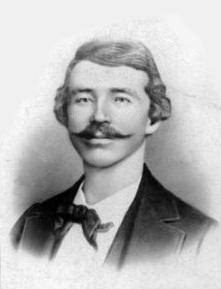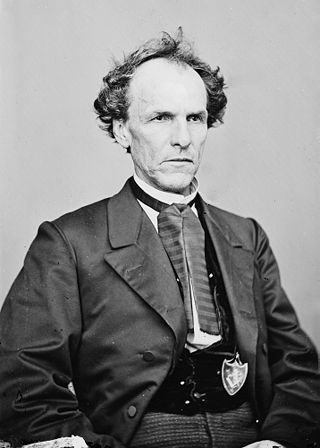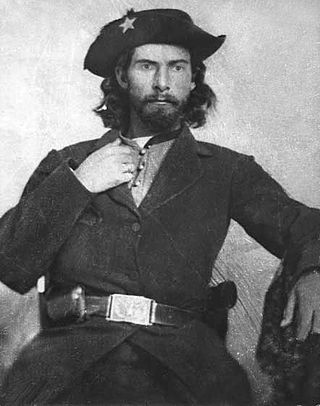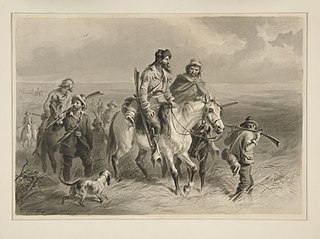
Ride with the Devil is a 1999 American revisionist Western film directed by Ang Lee and starring Tobey Maguire, Skeet Ulrich, Jeffrey Wright, Jewel in her feature film debut, Simon Baker, Jonathan Rhys Meyers, James Caviezel, Thomas Guiry and Jonathan Brandis. Based on the novel Woe to Live On, by Daniel Woodrell, the film, set during the American Civil War, follows a group of men who join the First Missouri Irregulars, also known as the Bushwhackers—guerrilla units loyal to pro-Confederacy units of the state—and their war against Northern Jayhawkers allied with the Union army.

In the American Civil War (1861–65), the border states or the Border South were four, later five, slave states in the Upper South that primarily supported the Union. They were Delaware, Maryland, Kentucky, and Missouri, and after 1863, the new state of West Virginia. To their north they bordered free states of the Union, and all but Delaware bordered slave states of the Confederacy to their south.

Quantrill's Raiders were the best-known of the pro-Confederate partisan guerrillas who fought in the American Civil War. Their leader was William Quantrill and they included Jesse James and his brother Frank.

William Clarke Quantrill was a Confederate guerrilla leader during the American Civil War.

Brigadier-General James Henry Lane was an American politician and military officer who was a leader of the Jayhawkers in the Bleeding Kansas period that immediately preceded the American Civil War. During the war itself, Lane served in the United States Senate and as a general officer in the Union Army. Although reelected as a Senator in 1865, Lane died by suicide the next year.

The Battle of Baxter Springs, more commonly known as the Baxter Springs Massacre, was a minor battle of the American Civil War fought on October 6, 1863, near the present-day town of Baxter Springs, Kansas.

The Lawrence Massacre was an attack during the American Civil War (1861–65) by Quantrill's Raiders, a Confederate guerrilla group led by William Quantrill, on the Unionist town of Lawrence, Kansas, killing around 150 men and boys.

William T. Anderson, known by the nickname "Bloody Bill" Anderson, was a soldier who was one of the deadliest and most notorious Confederate guerrilla leaders in the American Civil War. Anderson led a band of volunteer partisan raiders who targeted Union loyalists and federal soldiers in the states of Missouri and Kansas.

Border ruffians were proslavery raiders who crossed into the Kansas Territory from Missouri during the mid-19th century to help ensure the territory entered the United States as a slave state. Their activities formed a major part of a series of violent civil confrontations known as "Bleeding Kansas", which peaked from 1854 to 1858. Crimes committed by border ruffians included electoral fraud, intimidation, assault, property damage and murder; many border ruffians took pride in their reputation as criminals. After the outbreak of the American Civil War in 1861, many border ruffians fought on the side of the Confederate States of America as irregular bushwhackers.

Jayhawker and red leg are terms that came to prominence in Kansas Territory during the Bleeding Kansas period of the 1850s; they were adopted by militant bands affiliated with the free-state cause during the American Civil War. These gangs were guerrillas who often clashed with pro-slavery groups from Missouri, known at the time in Kansas Territory as "Border Ruffians" or "Bushwhackers". After the Civil War, the word "Jayhawker" became synonymous with the people of Kansas, or anybody born in Kansas. Today a modified version of the term, Jayhawk, is used as a nickname for a native-born Kansan.

General Order No. 11 is the title of a Union Army directive issued during the American Civil War on August 25, 1863, forcing the abandonment of rural areas in four counties in western Missouri. The order, issued by Union General Thomas Ewing, Jr., affected all rural residents regardless of their allegiance. Those who could prove their loyalty to the Union were permitted to stay in the affected area, but had to leave their farms and move to communities near military outposts. Those who could not do so had to vacate the area altogether.

Bushwhacking was a form of guerrilla warfare common during the American Revolutionary War, War of 1812, American Civil War and other conflicts in which there were large areas of contested land and few governmental resources to control these tracts. This was particularly prevalent in rural areas during the Civil War where there were sharp divisions between those favoring the Union and Confederacy in the conflict. The perpetrators of the attacks were called bushwhackers. The term "bushwhacking" is still in use today to describe ambushes done with the aim of attrition.

During the American Civil War, Missouri was a hotly contested border state populated by both Union and Confederate sympathizers. It sent armies, generals, and supplies to both sides, maintained dual governments, and endured a bloody neighbor-against-neighbor intrastate war within the larger national war.

At the outbreak of the American Civil War in April 1861, Kansas was the newest U.S. state, admitted just months earlier in January. The state had formally rejected slavery by popular vote and vowed to fight on the side of the Union, though ideological divisions with neighboring Missouri, a slave state, had led to violent conflict in previous years and persisted for the duration of the war.
The sacking of Osceola was a Kansas Jayhawker initiative on September 23, 1861, to push out pro-slavery Southerners at Osceola, Missouri. It was not authorized by Union military authorities but was the work of an informal group of anti-slavery Kansas "Jayhawkers". The town of 2,077 people was plundered and burned to the ground, 200 slaves were freed and nine local citizens were court-martialed and executed.
Hickman Mills is a neighborhood of Kansas City, Missouri in the Kansas City metropolitan area. There is good access to the Interstate and Federal highway system, with I-435, I-470, and US-71/I-49 running through the area, including the Grandview Triangle. It also includes Longview Lake and Longview Community College. It is covered by the Hickman Mills C-1 School District.

George M. Todd was an American Confederate guerrilla leader during the American Civil War who served under William C. Quantrill. A participant in numerous raids, including the Lawrence Massacre in 1863, he was ultimately killed at the Battle of Little Blue River in 1864.

Guerrilla warfare was waged during the American Civil War (1861–1865) by both sides of the conflict, but most notoriously by the Confederacy. It gathered in intensity as the war dragged.
James J. Chiles, also known as Jim Crow Chiles, was a Confederate outlaw who fought with Quantrill's Raiders.
John Noland was an enslaved man who was the personal servant of bushwhacker William C. Quantrill during the American Civil War. Noland was a chattel slave owned by Francis Asbury Noland in Jackson County, Missouri.














